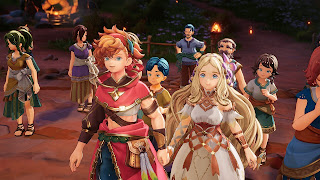The latest entry in the Mana series and its first new mainline title in nearly two decades, Visions of Mana blends open world exploration and action-based combat with many monster designs, artistic elements and gameplay traits that invoke its predecessors. But does this vision prove a worthy new entry to a fairly overlooked Square Enix franchise, or does it just lose sight of itself?
The Mana franchise was always a low-key favorite among Square fans, though sales for the series remained relatively low after Secret of Mana and it never saw much priority from Square Enix as a result. However, after the mobile spinoff Rise of Mana and the remakes of Secret and Trials proved to be successful, series producer Masaru Oyamada decided it was finally time to reinvigorate the series with an entirely new entry.
Of course, making something that appeals to long-time fans while having an identity of its own is no easy task, but Visions certainly tries its best. A lot of monster designs are taken straight from earlier games in the franchise, and the game features a class system somewhat similar to the one seen in Trials, with each characters' appearance, equipment and movesets changing depending on what elemental they have equipped. Visions retains the franchise's very colorful graphics, imaginative environments and expressive character designs as one would expect, and Hiroki Kikuta, Tsuyoshi Sekito and Ryo Yamazaki return to compose the soundtrack.
The game isn't a total retread of older elements, though. While still focused on action and exploration, Visions opts for a semi-open world style of design. While not completely free-roaming and it still retains a linear structure, there are quite large areas to explore between each major objective. This means there are quite a few collectibles to find, optional objectives to complete for extra rewards and hidden areas off the beaten path, some with enemies that are many levels above your party and can easily wipe you out if you're not careful. Chests and other useful points of interest are marked on the map, though it still takes a bit of searching to find them owing to them often being hidden by terrain or placed just out of reach until you unlock a later ability. Save points double as fast travel points which you can zip to at any time out of combat, which cuts down on quite a bit of tedious walking from point to point as you explore. You'll also have to return later on once you unlock new elementals to reach certain areas if you want full completion, as you often won't be able to reach certain items or open certain challenges your first time through.
Combat in Visions is fairly simple but serviceable, with a light attack, a slower but stronger attack and a dodge button, with skills accessible either via hotkeys or by pressing left or right on the D-pad to pause the action and bring up a "ring menu" of every skill/item available to your character. You can add new moves to your repertoire or upgrade your stats by purchasing class upgrades or equipping seeds. You also get something akin to a limit break in the form of a Class Strike - by dealing out and taking damage or smashing blue puts you fill up the blue meter at the bottom, and once it's filled to 100%, you can press L2 to unleash a powerful attack accompanied by a flashy animation for hefty damage. Completing battles efficiently (in a short period, without getting hit or using a Class Strike) earns small experience bonuses after the fight, which can be handy. One annoying thing is that the player cannot manually control the camera during battles and has to wait for it to slowly recenter onto a locked-on enemy, which can be annoying with faster enemies that tend to zip around the combat zone. Said combat zone also tends to be just a bit too small and running from battle entails pressing up against it for about two seconds; on more than a few occasions I tried to dodge away from attacks and ended up accidentally fleeing a fight. Bosses have multiple targets, with one usually designated as a weak point - striking there will deal extra damage and, after enough hits are landed, will stun them for a short time.
As an RPG Visions of Mana of course has no shortage of cutscenes, though they are surprisingly well-animated and staged, showcasing a lot of the series' glitzy presentation. Dialog in the game is surprisingly plentiful and pretty cheesy, but the voice acting is well directed. Een though it's an easy story to follow, they still see fit to give you a glossary, a brief summary of each major plot scene and profiles for every major character in the main menu. On a technical level the game runs well; I did encounter some occasional bits of hitching and frame-dropping but it doesn't hinder the experience much.
All told, Visions of Mana is a passable but not particularly interesting game. While everything here functions, nothing about it is particularly deep or innovative; but then again, Mana never really was. It's certainly got enough pretty graphics and music to retain its familiar following and if you're somehow still not bored of open world design and doodad-gathering there's plenty of that, but if you're not a devout series fan, this one probably won't do much to change your mind.


